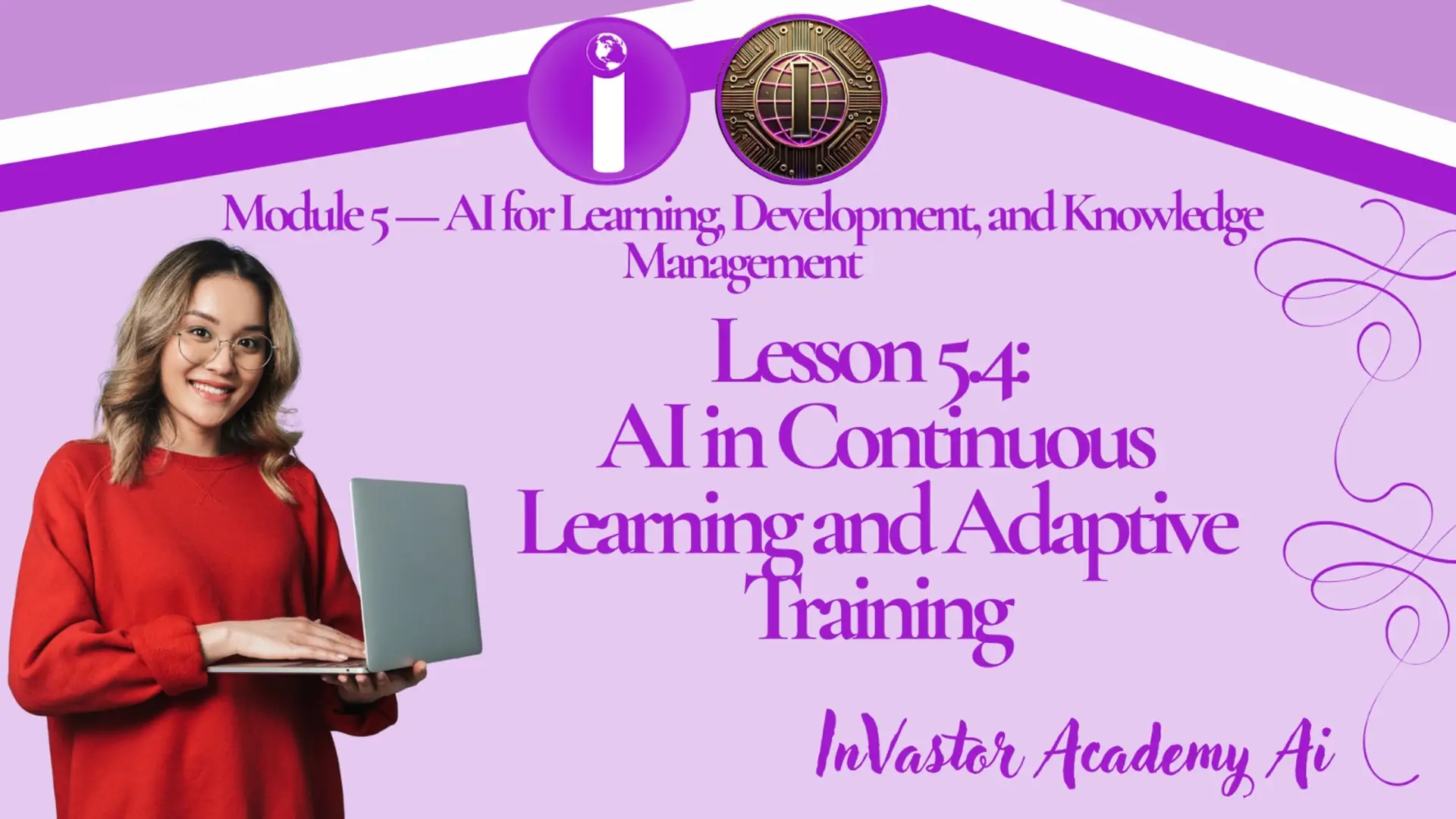

Lesson 5.4 — AI in Learning Analytics and Continuous Improvement
Module 5 — AI for Learning, Development, and Knowledge Management
Lesson 5.4 — AI in Learning Analytics and Continuous Improvement
Learning Objectives
By the end of this lesson, learners will be able to:
- Explain how AI enhances learning analytics and training evaluation.
- Identify data sources and metrics used to measure learning effectiveness.
- Understand how AI supports continuous improvement in learning programs.
- Evaluate the benefits and challenges of AI-driven learning insights.
- Apply best practices for using AI analytics to guide organizational learning strategies.
1️⃣ Introduction: From Learning Delivery to Learning Intelligence
In the past, organizations measured learning success using simple metrics — course completion rates, test scores, and attendance.
Today, AI-powered learning analytics enable deeper insights into how employees learn, apply, and grow.
By analyzing patterns in engagement, skill development, and performance, AI transforms learning systems into continuous improvement engines that evolve with each learner’s journey.
Example:
PwC uses AI-driven analytics to measure how employees apply newly acquired skills in real-world projects, linking training outcomes directly to business performance.
2️⃣ What Is Learning Analytics?
Learning analytics refers to the process of collecting, analyzing, and interpreting data about learners and their contexts — to understand and improve learning effectiveness.
AI enhances this process by automatically identifying trends, patterns, and improvement areas that human analysts might overlook.
Key Components of AI-Driven Learning Analytics:
- Data Collection: Tracks learning activities, engagement, and outcomes.
- Data Integration: Combines inputs from LMS, HR systems, and performance reviews.
- Predictive Analysis: Forecasts learner success or dropout risk.
- Prescriptive Insights: Suggests specific interventions for improvement.
- Visualization: Uses dashboards to show real-time progress and insights.
Example:
An AI-enabled platform can detect that employees in a leadership course struggle with strategic thinking modules — prompting trainers to revise or enhance the content.
3️⃣ How AI Improves Continuous Learning and Development
AI doesn’t just measure learning — it helps optimize it continuously.
By identifying what works, what doesn’t, and why, AI enables organizations to refine learning strategies in real time.
AI Function Description Example
Predictive Analytics Anticipates learner performance and engagement trends. Identifies who may need extra support.
Adaptive Learning Adjusts learning paths based on analytics. Customizes lessons for each learner.
Sentiment Analysis Analyzes feedback to measure learner satisfaction. Reviews comments and surveys automatically.
Content Optimization Suggests updates to training materials based on performance data. Recommends more interactive formats.
ROI Analysis Connects learning outcomes to business results. Links skill gains to productivity improvements.
Example:
LinkedIn Learning uses AI to analyze learner behavior across millions of users, refining its recommendation algorithms to improve course completion and satisfaction rates.
4️⃣ Benefits of AI in Learning Analytics
Benefit Description
📊 Deeper Insight Reveals how learning impacts performance and business goals.
🧠 Personalized Learning Paths Uses data to create targeted, adaptive learning experiences.
🔁 Continuous Improvement Enables real-time course and content optimization.
🕒 Efficiency and Focus Identifies high-impact training and eliminates ineffective modules.
💬 Evidence-Based Decisions Provides HR and L&D teams with concrete data for strategy alignment.
Example:
Google applies learning analytics to evaluate leadership development programs and uses insights to redesign its management training curriculum for better results.
5️⃣ Challenges and Ethical Considerations
While AI learning analytics offer transformative insights, they also present potential risks that must be managed responsibly.
⚠️ Data Privacy: Learner data must be securely stored and used with consent.
⚠️ Algorithmic Bias: Predictive models could misinterpret learner potential or engagement.
⚠️ Over-Surveillance: Excessive tracking can harm trust and motivation.
⚠️ Misaligned Metrics: Focusing on quantitative data may ignore qualitative learning outcomes.
⚠️ Complexity of Implementation: Integrating multiple data systems can be resource-intensive.
✅ Solution: Build transparent data governance frameworks, combine AI analysis with human judgment, and ensure that analytics serve the learner’s best interests.
6️⃣ Best Practices for Using AI in Learning Analytics
- Define Clear Learning Goals: Analytics should align with organizational and employee objectives.
- Use Diverse Data Sources: Combine learning, engagement, and performance data for a full picture.
- Maintain Transparency: Explain how AI analytics are used and what data is collected.
- Protect Data Privacy: Comply with legal and ethical standards such as GDPR.
- Blend AI with Human Oversight: Use AI insights as guidance, not as sole decision-makers.
- Encourage a Growth Mindset: Frame analytics as a development tool, not as surveillance.
Tip:
AI measures progress — but human leaders must nurture growth.
7️⃣ Practical Activity
Task:
Design a learning analytics dashboard concept for an organization (real or hypothetical).
Include:
- The types of data it tracks (e.g., engagement, performance, completion).
- AI features or tools used (e.g., predictive insights, adaptive learning).
- How results will be used to improve learning programs.
- Ethical considerations for data use and transparency.
8️⃣ Supplementary Resources
- 🎥 “The Power of Learning Analytics in Corporate Training” — Harvard Business Review
- 🎥 “AI in L&D: Turning Data into Learning Insights” — Deloitte Insights
- 🎥 “How Predictive Analytics is Changing Corporate Learning” — SHRM Learning Series
- 🎥 “Data-Driven Learning: Continuous Improvement with AI” — McKinsey Digital
Lesson Quiz 5.4
Please complete this quiz to check your understanding of the lesson. You must score at least 70% to pass this lesson quiz. This quiz counts toward your final certification progress.
Answer the quiz using the Google Form below.
Click here for Quiz 5.4
Conclusion
AI-driven learning analytics empower organizations to move from reactive training to proactive, data-informed development.
By continuously analyzing learning behavior and outcomes, AI helps HR and L&D professionals refine strategies, enhance engagement, and build a culture of lifelong learning.
💡 “AI provides the insight — but improvement comes from acting on it.”
📘 Next Lesson: Lesson 5.5 — Case Studies: AI-Powered Learning and Development Success Stories
📘 Previous Lesson: Lesson 5.3 — AI in Knowledge Management and Organizational Learning
📘 Course Outline: Module 5 — AI for Learning, Development, and Knowledge Management
Related Posts
© 2025 Invastor. All Rights Reserved

User Comments